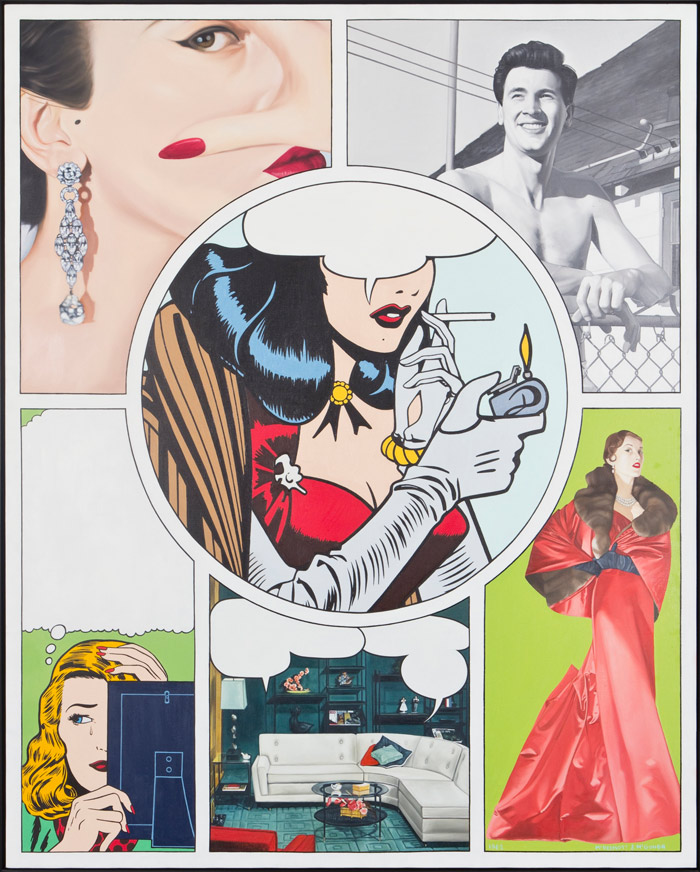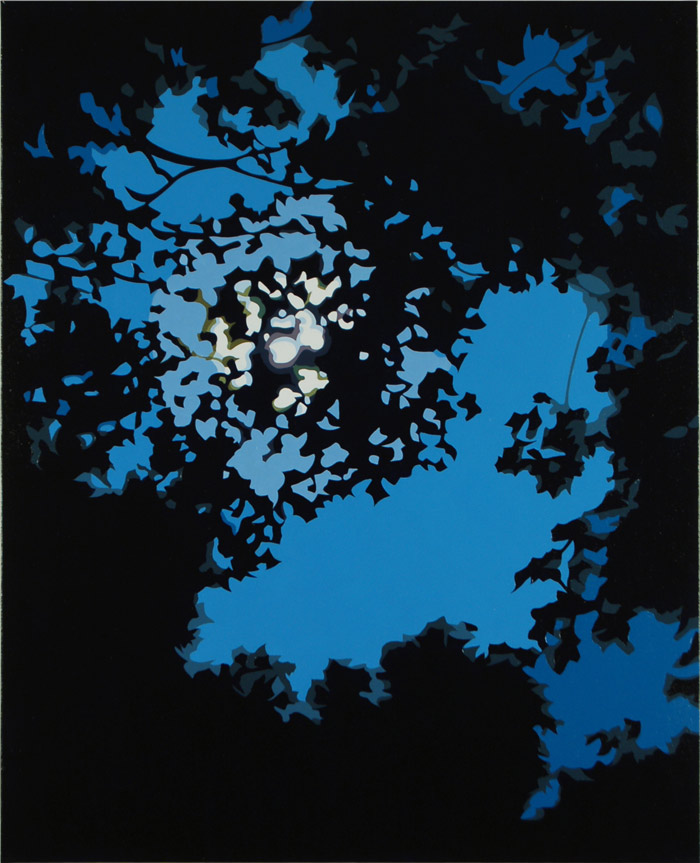James Salter’s short stories provide the underpinnings in which characters explore aspects of their relationships to both themselves and to others in “Last Night,” a subtly perceptive group exhibition curated by Merrill Mahan at Salomon Contemporary. Diverse media augment the narrative force of the stinging disclosures and personal inclinations inherent in the show’s theme. Framed and matted black and white ink jet prints, a color c-print, a pastel on paper and a text wall piece of poured mirrored glass, plus colorful paintings on linen, canvas and nylon, as well as graphite drawings on paper enhance the individuality that reinforces the theme “Last Night.” The roster of artists intent on making their personal statements features Richard Pasquarelli, Jocelyn Hobbie, Andrew Bush, Yvonne Jacquette, McDermott and McGough, Will Cotton, Ridley Howard, Amy Bennett, Matthew Pillsbury and Alexi Worth. From steamy disclosures to dreamy musings, prime ground is being mined.
This visual show is more cerebral than one might expect; it is in effect a compassionate salute to mankind’s groping efforts to clarify its feelings and achieve its desires in life. The select images illuminate concepts so varied in origin and execution that the display challenges viewer perceptions as to the creative uses and functions of media within the province of the visual. This unexpected challenge, paired with the post-modern and art historic trends within the structure of the show, lends the singular works on view a stellar sense of power. There is a thread in each unique vision (with the exception of Matthew Pillsbury’s prints), which lends an undercurrent of separation to the motifs. If this connotes the presence of an underlying existential angst, these artists experience the usual feelings fraught with hardships inherent in relationships through time.
While each artist’s issues vary, there are a few with tandem concerns that link their feelings and visions. Matthew Pillsbury’s evanescent archival pigment ink prints present beautifully realized interiors peopled with subjects who delight in both privacy and in company. These works relate to Richard Pasquarelli’s cropped enigmatic drawings of home exteriors, whose lighted facades suggest the presence of life and warmth within. Views of harmony at home veer sharply with the sensitively conceived Jocelyn Hobbie allegorical painting entitled Party, in which the pretty bright colors bring tension to the eternal narrative of the old being replaced by the young. This work makes a connection with the picture called Prognosis by Amy Bennett, that highlights the story of a group of relatives caught in the grip of the banal waiting that overlays the imminent terrors of a doctor’s utterances on the fate of a loved one. The small format projects a tense universal theme: that of death and its dreaded frightening impact.

McDermott & McGough, Something I’ve Never Had, 1965, 2006. Oil on canvas, 60 x 48 in., Photo credit Dave Rittinger. Courtesy of Salomon Contemporary, New York.
Taking a turn toward less critical, but still painful matters, the McDermott & McGough painting Something I’ve Never Had expresses a palpable emptiness; it highlights fashionable women, a handsome celebrity, designer clothing, jewels and fancy furniture in a remorseful expression of regrets for objects of desire that we perceive as permanently beyond our reach. The piece is created in a graphic, cartoon vernacular that features blank “word bubbles” conveying a sense of emotional bereftness. This sentiment is reiterated obliquely in Will Cotton’s Coconut Cake, a painting that yields a glimpse of a succulent girl whose mind seems preoccupied by the hopes of a wedding, as signaled by a small mountain of white cake. The piece recalls the French painters Boucher and Watteau; the girl is in effect a lovely piece of pastry. Her sad expression suggests thwarted wedding plans. Alexi Worth’s (oil on nylon) piece entitled Formalists and Ridley Howard’s (oil on linen) painting called Brown Leather Boots delve narrowly on select visions of the female form, as expressed within the limits of a specific sense of feminine allure.
On first glance, Richard Pasquarelli’s work Night Sky (a sly reference to Van Gogh) has “romantic” underpinnings; it is after all a sublime vision of nocturnal majesty. But the spidery dark web-like leaves hover over and mingle with the moonlit night sky, obliterating its unblemished purity. There is a viewing distance to this work; a close look reveals the subtle tonal shifts in sky and leaf fringes that imbue the work with richness and sophisticated painting variations. The drawings, which at first appear to be nondescript views of the doors and windows of suburban dwellings, exude an aura of secrecy. One wonders what goes on inside these closed doors and shuttered windows. On another note, the Andrew Bush digital c-print displays a lone itinerant driver set in an isolated car with no visible landmarks to indicate its location. The title speaks to the aimlessness that is bred by the American car culture. It is practically an essay in itself; Man Drifting Northwest at Approximately 68 M.P.H. on U.S. Route 101 Somewhere near Camarillo, California, One Evening in 1989.
There are more poetic subtle interpretations and variations of individuals, their lives, their fantasies, their families, our earth and its promises than one observes on a first view. Yvonne Jacquette’s pastel, Maine Night Lights A, displays a dark ariel view of colored urban night-lights that form the outline of a satirical sky-lit bird constellation. Living bird formations could hardly survive in the murky sky that speaks of the possible presence of smog, or a brewing storm that mars the night sky view. The variety of expression with the attendant tension of opposition within the show, in response to the open-ended narrative of the theme, provides an emotional edge that accelerates the charged proceedings. The Andrew Bush c-print adds a touch of Americana, in the car culture in which people seek answers to life’s problems by taking road trips. Rob Wynne’s ironical wall work entitled Chemistry, conveys with its irregular fonts the vagaries of that human phenomenon that explains so much, without saying a word!
By Mary Hrbacek
























